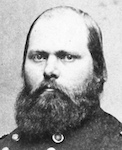 Open main menu
Open main menu
 Open main menu
Open main menu

G.L. Hartsuff
(1830 - 1874)
Home State: New York
Education: US Military Academy, West Point, NY, Class of 1852;Class Rank: 19th
Command Billet: Brigade Commander
Branch of Service: Infantry
Before Antietam
Raised in Michigan, he graduated from West Point in 1852. He was assigned briefly to the 4th US Artillery, and in 1853 was commissioned 2nd Lieutenant in the 1st Artillery. He was promoted to 1st Lieutenant in 1855. He was in in Florida in the Seminole War (1855-6), and was wounded in the chest and arm in action there on 20 December 1855, but the bullet was never removed. He was then an instructor of Artillery and Infantry Tactics at West Point.
Early in the Civil War he served at Fort Pickens, Florida, and as Captain and Assistant Adjutant General (AAG) to General Rosecrans in Western Virginia, but was appointed Brigadier General of Volunteers in April 1862.
On the Campaign
Commanding the 3rd Brigade, 2nd Division of the I Corps, he was wounded by gunshot to the left sacroiliac (pelvis) in action on 17 September. He was relieved in command of the Brigade by Colonel Coulter of the 11th Pennsylvania Infantry.
The rest of the War
He was treated on the field and at the Ramsey House on Record Street in Frederick, MD, where he was visited by President Lincoln on 4 October 1862. By then in a hospital in Washington, DC, he was promoted to Major General of Volunteers in November 1862, and returned to active duty in May 1863 after his wound finally closed, though, again, the bullet was never found. He served in administrative command positions to the end of the War. His last post, in April 1865, was as Military Commander of Petersburg, Virginia with headquarters at Centre Hill.
After the War
At War's end he was honored by brevet for "gallant and meritorious service" for Antietam (Bvt. Colonel), the Appomattox Campaign (bvt. Brig. Gen.), and war service (bvt. Maj. Gen.). During the War years he had been successively promoted in the Regular Army Adjutant General Department to Captain (1861), Major (1862), and Lieutenant Colonel (1864).
He continued in service in administrative jobs in the West and retired for disability, at the rank of Major General, on 29 June 1871. He died of pneumonia associated with his Seminole wound in New York City in 1874, just 43 years old.
References & notes
Service data from Heitman1 and Appleton's.2 His wound and hospital details from Nelson3 and Dr. Jack D. Welsh's Medical Histories of Union Generals (1996). His gravesite is online from Findagrave. His picture from a CDV photograph sold in 2016 by Heritage Auctions. Fort Hartsuff, Nebraska (1874-1881) was named for him.
Birth
05/28/1830; Tyre, NY
Death
05/16/1874; New York, NY; burial in US Military Academy Post Cemetery, West Point, NY
1 Heitman, Francis Bernard, Historical Register and Dictionary of the United States Army 1789-1903, 2 volumes, Washington DC: US Government Printing Office, 1903, pg. 507 [AotW citation 515]
2 Fiske, John, and James Grant Wilson, editors, Appleton's Cyclopedia of American Biography, 6 vols., New York City: D. Appleton and Company, 1887-1889, Vol. 3, pg. 106 [AotW citation 516]
3 Nelson, John H., As Grain Falls Before the Reaper: The Federal Hospital Sites and Identified Federal Casualties at Antietam, Hagerstown: John H. Nelson, 2004, pg. 239 [AotW citation 18640]